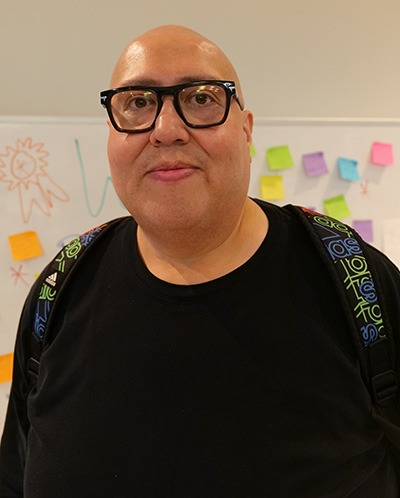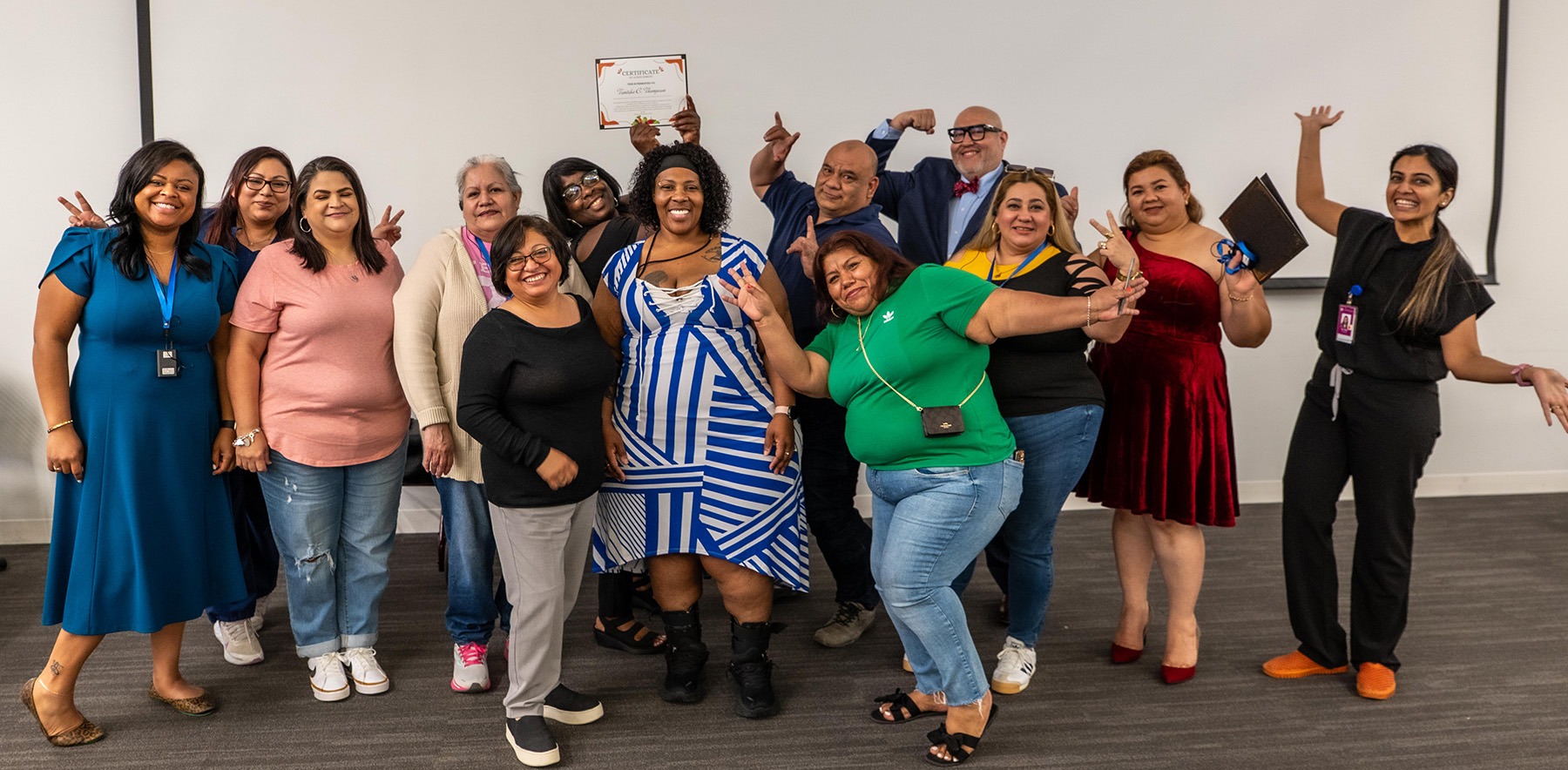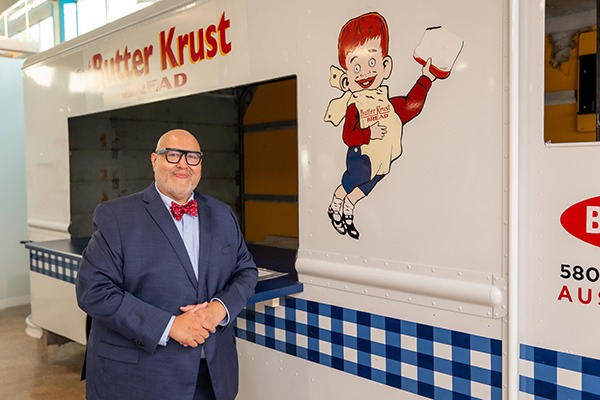June 11, 2025
As part of a medical optimization pilot program with Central Health, two Austin residents vowed to lose more than just weight: They also aimed to reclaim their lives.
AUSTIN, Texas—In March, Stephen walked into his local H-E-B on the east side of town with a smile on his face.
Buying food hadn’t always been easy.
But it had been just over three months since he enrolled in a specialized medical weight loss program with Central Health called “Choose to Lose,” and he had lost a total of 12 pounds. At this point, Stephen’s clothes felt a little looser. But maybe his mind was a little more focused, too?
“All these beautiful colors,” he said as he pointed to a bevy of oranges, apples and pineapples in the fruit aisle, “we want to put them in our food.”
Ten years ago, Stephen had clawed his way down from 420 to 240 pounds, through discipline and changes to bad habits. But old patterns crept back in, and the weight followed.
Now at 337, much of his hard-won progress had been undone.
“Eating–it’s a chess game of the mind,” the 49-year-old said.

A total of 26 patients, all arriving from different parts of Travis County, began their weight loss journeys with Central Health’s medical optimization program in January, too, aiming to combat chronic disease and live healthier lives. The enrollees, women and men alike, represented a cross-section of Central Health’s patient population. And demographically, there was a strong case for why this health care program was necessary. Central Health’s 2024 Demographic Report revealed that cardiovascular disease (CVD) and high blood pressure (hypertension) were two chronic conditions most diagnosed in Travis County among residents with low income. And diabetes wasn’t far behind.
When the medical optimization program started, Stephen’s average blood sugar levels (otherwise known as hemoglobin A1c) were at dangerous levels, which prompted concern. As a type-2 diabetic, he knew there would be consequences if it was left unchecked.
“My health goals for medical optimization are obviously, number one, starting to learn to eat healthier,” he said.
A Medical Weight Loss Program Built for Travis County Residents
Central Health created the medical optimization pilot to treat and prevent obesity-related chronic health conditions. To qualify, enrollees met criteria for obesity—body mass indexes (BMI) greater than 30, or being overweight (BMIs over 27) with an obesity-related illness like diabetes.
Health care systems can achieve these goals through a variety of strategies, from managing chronic conditions via primary and specialty care, to improving outcomes with pharmacy management and medication, to building personalized nutrition plans and providing counseling and treatment for underlying mental health disorders.
“This is really an opportunity to make a lifestyle change and do some treatment and help reduce the weight but also help with some of those conditions related to it,” said Dr. MiLinda Zabramba, Central Health’s associate medical director and founder of the program.

For medical optimization, a series of instructional classes were held at Central Health’s Capital Plaza Specialty Clinic. What patients learned quickly was that, statistically, weight can have a direct impact on a health outcome, specifically when it comes to the heart.
Cardiovascular disease (CVD) is the number one cause of death in the United States. It can lead to heart disease and stroke, heart failure and arrhythmia, and a number of other life-threatening conditions. A total of 26,783 enrollees in Central Health’s Medical Access Program (MAP) or MAP Basic, two medical coverage options for residents of Travis County with low income, were diagnosed with CVD in 2023, according to Central Health’s 2024 Demographic Report. A total of 22,653 enrollees were diagnosed with hypertension, and roughly 13,600 were scanned for type-II diabetes. So, the facts were simple: health starts with regular physical activity and healthy eating.
Each medical optimization class was led by a Central Health medical professional—from licensed physicians, dietitians, and clinical social workers—and over the course of just over four months, medical providers monitored the progress of students. Every enrolled individual had access to medical management, behavioral counseling, pharmacist consultation, and nutritional planning.
“Chronic disease is costly,” Dr. Zabramba said. “If it’s not controlled early on, you can end up with complications down the line.”
After seven classes, students officially graduated on April 16, completing the first phase of the cohort. The next phase includes follow-ups with medical providers over longer increments throughout the year.

“We want to foster an environment that brings in past successes, and incorporates new skills,” said Cheryl Njapau, a clinical social worker and behavioral health therapist who worked closely with the patients. “We don’t want to create an environment that’s restrictive and setting someone up to fail.”
A Change of Pace for a Travis County Mother
María had spent much of her life tending to her three children as a homemaker in North Austin. A native of Mexico, the 48-year-old grew up in San Louis Potosi, a mining town known for delicacies like enchiladas potosinas¾tortillas dipped in chili sauce and filled with goat cheese.
She started the program with hypertension and a recent emergency room visit that scared her. Her inclusions came at an opportune time: She said she didn’t want to miss a chance to become healthier. “(This is) for me, myself and I,” she said (disclosure: our interview was translated from an interpreter).
When her hypertension got out of control late last year, María said, she felt like she needed to course correct. She was referred to the medical optimization program by her specialist.
“I didn’t have a specific goal when I started this,” she said. “I just wanted to lose some weight, be healthy and feel good, and feel like I look better. But as I’ve been going, I think this just fell into my lap. God was a part of this, and He brought this to my attention.”
Through medication, her high blood pressure levels began to decline. By the sixth week of the class, María said, her doctor told her she could start working off the medication.
“It’s been good,” she said.

Building Strong Habits in Medical Optimization
Students were handed a large white binder full of educational handouts and prompts for reflection on the first day of the medical optimization program and asked to journal their progress. Over 14 weeks, that investment was the spark for building new habits.
Stephen, a former project manager currently studying physical therapy at Austin Community College, had been tracking his A1-C from the beginning.
By March, he said, his hemoglobin a1c had gone from 10.1 to 7, a reduction on paper of nearly 100 milligrams per deciliter (mg/dl). To get into the green zone—considered a healthier level—Stephen was looking to take his average to a 5 or a 6. Statistically, that could be the difference in achieving long-term health. What helped over that span was his usage of Ozempic, an antidiabetic medication used to lower long-term health risks.
“We don’t want to create an environment that’s restrictive and setting someone up to fail.”
“High blood sugar is not always a bad thing, but it’s about what it does to your body over time,” Dr. Zabramba said. “It can cause dehydration. It can affect your kidney function and put you at increased risk for heart disease and vascular disease, so bringing blood sugars under control can reduce your risk factors.”
A Class Graduates from Medical Optimization

The final instruction on graduation day began with a familiar face and a familiar request.
“We want to get to a place of center,” said Njapau, the clinical social worker and behavioral therapist.
A breath in. A breath out.
This was a common exercise with Njapau. And by concluding the program with breathwork, it was a reminder to everyone to embrace what the last four months meant to them.
“The breath tries to answer the question of, ‘Why am I doing this?’” she said. “And the breath at the end signals the end of that as well.”
Stephen certainly did not take the lesson lightly. Dressed in a blue suit with a neatly wound red bowtie, he sat in the front row of a massive conference room. Closing his eyes, he imagined the lighter world he wanted to live in.

“The biggest takeaway from the program was the mental aspect,” he said.
Just a few feet away was María. Wearing a bright green shirt and jeans—her son Alexander to her right—she couldn’t help but smile, too.
“What’s really beautiful for me is that I have felt really supported,” she said.
Both were among the strongest success stories over the 14-week program.
Stephen had turned 50 just two weeks earlier, during a time when his body was changing, when his habits were re-wiring. He lost a total of 15 pounds and was down to 323. Most important, though, was his belief and understanding on how to better approach food consumption.
“It was working with Cheryl and trying to curtail anxiety,” he said. “That it’s OK not to be perfect.”
María, meanwhile, was in a much better place with her hypertension. Central Health’s providers had met with her three separate times over the medical optimization program, and each time, she said, they found that her blood pressure was improving.
“After I started this process,” she said. “I was starting to feel better the way I have in the past. I decided to stop taking the medication. And since I have frequent checkups and they’re checking my blood pressure, I’ve seen that my levels are normal.”
“The biggest takeaway from the program was the mental aspect.”
It would have been almost impossible for anyone to completely change themselves in four months. As other enrollees found, there were an equal number of ebbs and flows.
But in Stephen’s mind, he had found a sense of peace through the process.
“I wanted to fix myself because of all the immobility issues that happened with me,” he said. “All the inactivity, the COVID, gaining 20 pounds, losing 20 pounds, gaining 20 pounds back. All those things, I wanted to learn how I could fix myself.”
María, meanwhile, found a community. She believed the changes she was making would continue.
“I know it hasn’t been that long,” she said, “but I’m going to keep moving forward. There are going to be more and more changes.”